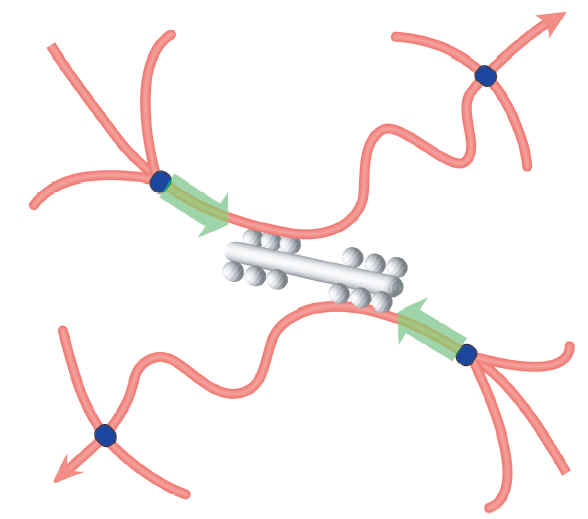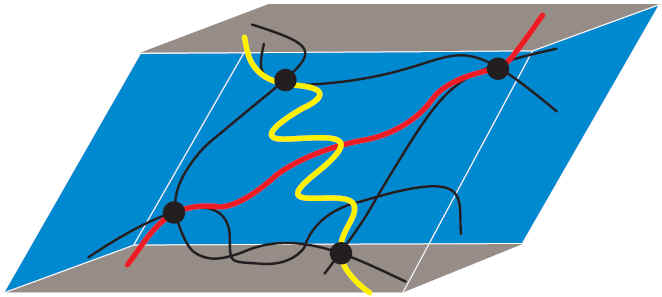





|
|
Our research interests concern the fundamental physics of soft matter, of
which biological materials are principal examples. While our understanding of
the single-molecule properties of many of the key building blocks of the cell is
relatively advanced, our understanding of the basic physics governing biological
assemblies from the nanometer to the micrometer scales is, by comparison, still
rudimentary. Many sub-cellular structures involve the coordinated assembly of
disparate elements such as soft membranes and stiff filamentous proteins. Our
specific research interests include the structural, mechanical and dynamic
properties of these and other soft materials.
Topics of current interest:
Some recent highlights:
D Mizuno, C Tardin, CF Schmidt, FC MacKintosh,
Nonequilibrium mechanics of
active cytoskeletal networks.
Science, 315:370 (2007).
 Cells
both actively generate and sensitively react to forces
through their mechanical framework, the cytoskeleton,
which is a nonequilibrium composite material including
polymers and motor proteins. We study the dynamics and
mechanical properties of a simple model cytoskeleton and
show that stresses arising from motor activity control
the network mechanics, increasing stiffness by a factor
of nearly 100 and qualitatively changing the
viscoelastic response of the network. We present a
quantitative theoretical model connecting the
large-scale properties of this active gel to molecular
force generation. Cells
both actively generate and sensitively react to forces
through their mechanical framework, the cytoskeleton,
which is a nonequilibrium composite material including
polymers and motor proteins. We study the dynamics and
mechanical properties of a simple model cytoskeleton and
show that stresses arising from motor activity control
the network mechanics, increasing stiffness by a factor
of nearly 100 and qualitatively changing the
viscoelastic response of the network. We present a
quantitative theoretical model connecting the
large-scale properties of this active gel to molecular
force generation. |
| |
PA Janmey, ME McCormick, S Rammensee, J Leight, P
Georges, and FC MacKintosh,
Negative normal stress in semiflexible biopolymer gels.
Nature Materials, 6:48 (2007).
 When
subject to stress or external loads, most materials
resist deformation. Any stable material, for instance,
resists compression—even liquids. Solids also resist
simple shear deformations that conserve volume. Under
shear, however, most materials also have a tendency to
expand in the direction perpendicular to the applied
shear stress, a response that is known as positive
normal stress. Here, we show that networks of
semiflexible biopolymers such as those that make up both
the cytoskeleton of cells and the extracellular matrix
exhibit the opposite tendency: when sheared between two
plates, they tend to pull the plates together. We show
that these negative normal stresses can be as large as
the shear stress and that this property is directly
related to the nonlinear strain stiffening behavior of
biopolymer gels. When
subject to stress or external loads, most materials
resist deformation. Any stable material, for instance,
resists compression—even liquids. Solids also resist
simple shear deformations that conserve volume. Under
shear, however, most materials also have a tendency to
expand in the direction perpendicular to the applied
shear stress, a response that is known as positive
normal stress. Here, we show that networks of
semiflexible biopolymers such as those that make up both
the cytoskeleton of cells and the extracellular matrix
exhibit the opposite tendency: when sheared between two
plates, they tend to pull the plates together. We show
that these negative normal stresses can be as large as
the shear stress and that this property is directly
related to the nonlinear strain stiffening behavior of
biopolymer gels. |
| |
CP Brangwynne, FC MacKintosh, S Kumar, NA Geisse, J
Talbot, L Mahadevan, KK Parker, DE Ingber, and DA Weitz,
Microtubules can bear enhanced compressive loads in
living cells because of lateral reinforcement.
Journal of Cell Biology, 173: 733 (2006). |
| |
M
Atakhorrami, GH Koenderink, CF Schmidt, and FC MacKintosh,
Short-time
inertial response of viscoelastic fluids: Observation of vortex propagation.
Physical Review Letters, (2005). 95: 208302. |
| |
TB
Liverpool and FC MacKintosh,
Inertial effects in the response of viscous
and viscoelastic fluids.
Physical Review Letters, (2005). 95:
208303. |
| |
|
|
|
|

